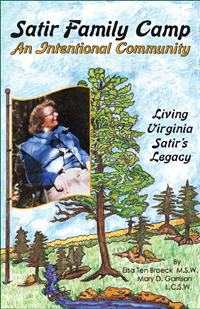 Satir Family Camp
Satir Family Camp
An Intentional Community
Elsa Ten Broeck,M.S.W. •
Mary D.Garrison, L.C.S.W.
280 pages
ISBN 978-0-8314-0094-1
$16.95
Virginia’s Visionary Development of
Intentional Communities
In 1977, Virginia Satir created a community known as Satir Family Camp, which
brought families to live together in the wilderness for one week each year. That
community continues to this day, as both a living legacy to Virginia and one of
her best-kept secrets. This book is the first written account of Satir Family Camp
(SFC) and the therapeutic work Virginia did there. It shares the camp’s history and
describes how the community has grown and changed over the years.
Using stories, illustrations, and photographs, the book demonstrates how
SFC utilizes Virginia’s theories, techniques, and teachings to support and guide
a unique communal experience now being shared by a third generation of
Satir Family Campers.
We use two voices to depict SFC. In one voice, we describe the history and tell
the stories; in another, we analyze the different stages of intentional community
development. This book shows how a community of families can live together
and practice Virginia’s principles for “becoming fully human.” It also discusses
some of the significant challenges the community has faced over the past
quarter-century .Growing beyond Virginia’s initial dream, the camp has not only
survived for over twenty-five years but has thrived even in the most difficult of
times. We include an analysis of how Virginia both created some of those
challenges and provided the knowledge and skills to deal with them.
Throughout this retrospective, readers find stories and statements that reflect
the experiences of Satir Family Camp members as well as friends and colleagues
from Virginia’s life. In some places, we have quoted people directly; in others, we
describe events that happened at camp. To assure confidentiality, we have changed
the names of campers who participated in those events. To help illustrate how the
SFC community developed, we have also created certain stories. The characters
in those stories are composites rather than actual campers. In all instances,
actual or fictional, we have tried to be faithful to the voices of the people who are
or who have been part of the community.
Finally,readers can discover how Virginia’s life, principles, and models influenced
and shaped the wonderful mystery of this intentional community. After careful
study of her work and discussions with her colleagues, we also postulate a model
of community development that we believe Virginia might have envisioned.